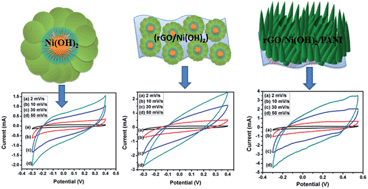High performance supercapacitor electrode material based on vertically aligned PANI grown on reduced graphene oxide/Ni(OH)2 hybrid composite†
Abstract
A simple and cost effective one pot hydrothermal process has been followed for the synthesis of flowery Ni(OH)2, reduced graphene oxide (rGO)/Ni(OH)2 hybrid composite. A ternary composite of rGO/Ni(OH)2/PANI has also been synthesised by in situ oxidative polymerisation of aniline with the binary composite of rGO/Ni(OH)2. A unique morphology of vertically aligned PANI on rGO surface and randomly connected PANI nanowires has been demonstrated following a heterogeneous nucleation on the rGO surface and homogeneous nucleation inside the bulk material. A comparative electrochemical analysis reveals a superior electrochemical behavior of the ternary composite over the rGO–Ni(OH)2, which again shows better electrochemical utility over the virgin Ni(OH)2. The proton insertion/deinsertion reversible pseudocapacitance of Ni(OH)2 combined with the pseudocapacitance of the vertically aligned conducting PANI nanowires and their synergistic effect with in situ reduced graphene oxide results in a high specific capacitance of 514 F g−1 at 2 A g−1 current density accompanied with 94.4% specific capacitance retention after 1000 charge discharge cycles at 5 A g−1 current density.


 Please wait while we load your content...
Please wait while we load your content...